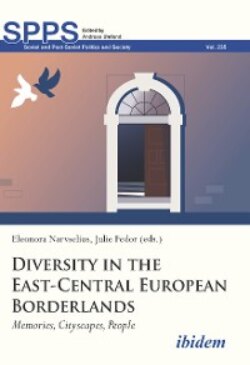Читать книгу Diversity in the East-Central European Borderlands - Группа авторов - Страница 4
На сайте Литреса книга снята с продажи.
List of Figures
ОглавлениеFigure 2.1. Chişinău. Background map from 1941, showing streets where inhabitants and property owners were registered in 1930 or 1940, according to archival material.
Figure 2.2. Chişinău. Property owners around Piaţa Veche (the Old Market) in 1930.
Figure 2.3. Chişinău. Buildings and property owners in 1940 along the central part of Strada Mihai Viteazu (present-day Strada Mihai Eminescu).
Figure 2.4. Chernivtsi. Streets where inhabitants or property owners in 1912, 1936, or 1940 are registered, based on archival material.
Figure 2.5. Chernivtsi. Buildings and property owners at Springbrunnengasse (interwar Strada Fântanei, present-day Vulytsya Petra Sahaydachnoho) and Synagogengasse (interwar Strada Wilson, later Vulytsya Henri Barbusse’a, now again Vulytsya Synahohy) in 1912 in the Lower Town.
Figure 2.6. Chernivtsi. Buildings, users, and inhabitants at Piaţa Unirii (Austrian Ringplatz, present-day Ploshcha Tsentral’na), Strada Bucureştilor (Austrian Postgasse, present-day Vulytsya Khudyakova), and the southern part of Strada Regele Ferdinand (Austrian Enzenberg Hauptstrasse, present-day Holovna vulytsya) in 1936 and earlier.
Figure 2.7. L’viv. Streets where property owners or business activities were registered in 1929 and in some cases earlier, based on archival material.
Figure 2.8. L’viv. Buildings and business activities in 1929 and earlier around Rynek (present Ploshcha Rynok).
Figure 2.9. L’viv. Buildings and business activities in 1929 along the middle part of Ulica Zamarstynowska (present Vulytsya Zamarstynivs’ka).
Figure 2.10. Wrocław. Streets where inhabitants and users in 1936 are registered, according to archival material.
Figure 2.11. Wrocław. Buildings and business activities in 1936 around Ringplatz (present Rynek).
Figure 2.12. Wrocław. Buildings and business activities in 1936 around Wallstraße (present-day ulica Pawła Włodkowa) and Antonienstraße (present-day ulica Świętiego Antoniego).
Figure 3.1. Panoramic view of Pidzamche from the High Castle (circa 1960s–80s).
Figure 3.2. People on the streets of Pidzamche. Collage made of photos from Urban Media Archive, Center for Urban History of East Central Europe, Lviv.
Figure 6.1. Chişinău, former yeshiva Magen Dovid and former synagogue named after Yehuda Leib Tsirelson.
Figure 6.2. Chişinău, former pre-burial house Bait Tahara at the Jewish cemetery.
Figure 6.3. Memorial to the Victims of Chişinău Ghetto (1993).
Figure 6.4. Memorial to the Victims of Chişinău Pogrom of 1903 (1993/2003).
Figure 6.5. Memorial to the Victims of Fascism (1982/2015).
Figure 6.6. Manuc Bey Manor Museum Complex, Hînceşti; the palace before the works began (2013).
Figure 6.7. Manuc Bey Manor Museum Complex, Hînceşti; the palace during the works (2015).
Figure 6.8. Manuc Bey Manor Museum Complex, Hînceşti; the palace after completion of the restoration works (2015).
Figure 7.1. Plastic scale model of old Lwów in Wrocław.
Figure 7.2. How to commemorate the past of Wrocław?
Figure 7.3. Recognition of monuments among the inhabitants of Wrocław.
Figure 7.4. Lwów myth: beliefs about the Lwów orgin of the Wrocław settlers.
Figure 7.5. What should be remembered from Wrocław’s history?
Figure 7.6. Attitudes toward history of Wrocław.
Figure 7.7. Local identity between myth and history.
Figure 8.1. Monument to the Lwów professors in Wrocław. Sculptor Borys Michałowski.
Figure 8.2. The restored Soviet monument with a changed dedication that now reads: “To researchers from the Lviv Polytechnic Institute who fell during World War II".
Figure 8.3. The new monument on the Wuleckie Hills unveiled in 2011.
Figure 9.1. Eternitate memorial complex, view from the main entrance.
Figure 9.2. One of sculptures at the memorial complex, displaying different stages of the Soviet war effort.
Figure 9.3. Section celebrating the “compatriots” awarded the title “Hero of the Soviet Union” or the “Order of Glory,” originating from the territories of the future Republic of Moldova.
Figure 9.4. Monument commemorating the Hungarian POWs who died in Soviet captivity on the territory of present-day Republic of Moldova in 1945–48 (erected in 2015).
Figure 9.5. Plaque reading: “An alley of Kazakh apple trees, planted by the General Consulate of the Republic of Kazakhstan in Chişinău with the support of civil organizations of the Republic of Moldova in the memory of those who died in the Great Patriotic War. 24.04.2015” (erected in 2015).
Figure 9.6. Section of the memorial complex dedicated to those “fallen” in the 1992 Transnistrian conflict (erected in 1998).
Figure 10.1. A model of three strategies for interpreting the city’s past in its temporal and spatial dimensions.
Figure 10.2. Importance of the past for different age groups in Wrocław; a representative population sample, N=547.
Figure 10.3. Importance of the past in Wrocław.
Figure 10.4. The index of acceptance of a name change in Wrocław, differentiation by level of conservatism.
Figure 10.5. The criteria of the perception of historical urban space in Wrocław, differentiation by occupation.
Figure 10.6. The criteria of the perception of historical urban space in Wrocław, differentiation by educational attainment.
Figure 10.7. The criteria of the perception of historical urban space in Wrocław, differentiation by level of religious conservatism.
Figure 10.8. The criteria of the perception of historical urban space in Wrocław, differentiation by party affiliation.
Figure 11.1. Different layers of self-identification in the Region of Bukovina.
Figure 11.2. (Un)willingness to move away from the region/locality: Results for variable 1 “I will do my best to move away from here,” and variable 2 “Given the chance, I would gladly move to Romania/Ukraine.”
Figure 11.3. Native language in Bukovina.
Figure 11.4. Everyday language practices in the northern and southern parts of Bukovina.
